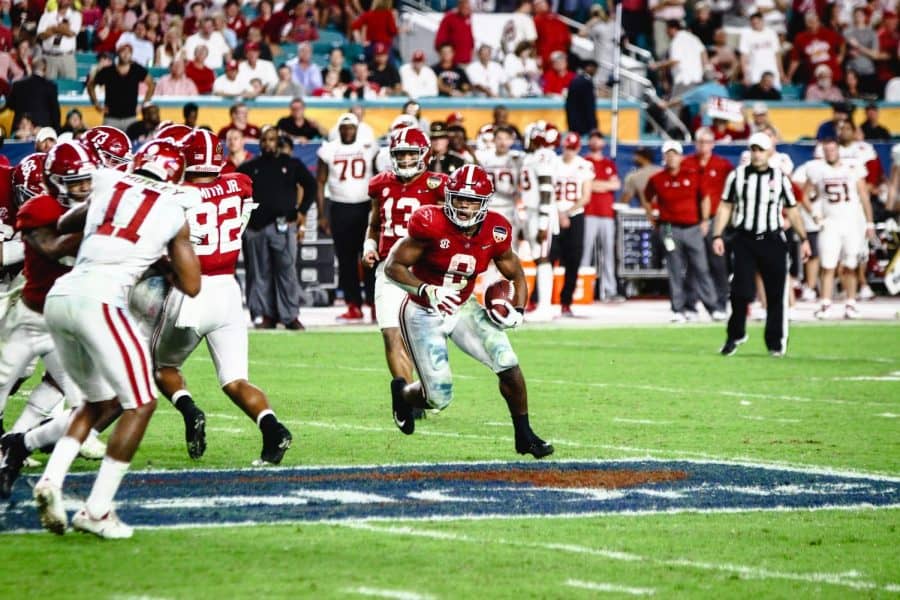National championship may test Alabama’s ability to close
January 6, 2019
Over coach Nick Saban’s 12 seasons at Alabama, some of his teams’ most distinctive features – like huge, space-eating defensive tackles and an offense based on a smashmouth running game – have faded away, completing a shift to quicker linemen with more pass-rush ability and a more balanced offense.
At the start of this season, it appeared that the team’s ability to convert a late lead into a win by controlling the clock may have been following the same path.
In the season opener against Louisville, the offense got the ball back with 5:38 to play. Three plays later, it punted, having possessed the ball for under two minutes. The offense had two more three-and-outs the next week against Arkansas State, followed by two more on the road at Ole Miss.
It finally got a first down on a potential game-ending drive against Texas A&M, but Saban had seen enough. Even though his Crimson Tide was 4-0 with an average victory margin of 41 points, he wanted to see his running game step on the opponents’ jugular, knowing more stern tests were to come.
“We’ve got to be able to finish the game,” Saban said after the A&M game. “They should never get the ball back at the end of the game. One of these days we’re going to be in a situation where a team goes two-minute to go score and win the game.”
A breakthrough came the next week against Louisiana-Lafayette. Leading 56-14, Alabama’s offense trotted onto the field with 3:58 remaining, ran the ball seven times, converted three first downs, and put the game on ice.
In the next three games, an 11-play drive took up seven of the game’s final nine minutes at Arkansas, a nine-play drive left seven seconds on the clock vs. Missouri, and a 14-play drive at Tennessee took up nearly 10 minutes.
“It just goes hand in hand with how the guys have jelled and molded together,” offensive line coach Brent Key said. “It’s not just five guys on the offensive line; it’s the sixth and seventh and eighth guy that play a lot of valuable reps, as well as the tight ends and running backs and all of them getting on the same page.”
Until its 45-34 Orange Bowl win over Oklahoma, Alabama was never in dire need of a lengthy drive to stave off an opponent’s attempt at a comeback. With the Sooners’ top-ranked offense moving up and down the field repeatedly in the second half, the Crimson Tide had to keep Heisman Trophy-winning quarterback Kyler Murray on the sideline to ensure a fourth consecutive berth in the national championship.
Offensive coordinator Mike Locksley called run after run as his offensive line opened lanes for his running backs – and quarterback Tua Tagovailoa on a crucial third-and-3 with two minutes left – to move the chains.
After seven straight plays gained positive yardage, the Crimson Tide had enough leeway to endure two negative ones: Tagovailoa kneel-downs as the clock expired.
“The victory formation is the best formation in football,” senior running back Damien Harris said. “For us to be able to do that, I think that shows that we’ve improved a lot on offense and that’s an area we’ve been able to get better in.”
For various reasons, Alabama hasn’t needed to go on long drives to salt away four of its previous five national championships. A Texas fumble deep in its own territory in 2009, a three-score lead in a defensive slugfest in 2011, and a blowout in 2012 made it unnecessary “Second-and-26” speaks for itself.
But three years ago, in the first meeting of the now-perennial series between Alabama and Clemson, the Crimson Tide needed a late drive to clinch the win in an instant classic.
An eight-play, three-and-a-half-minute drive capped by a Derrick Henry touchdown run on third-and-goal did just that. It also began a title tug-of-war that continues on Monday night.




















![NEWS | The University provided the UA Young Americans for Freedom chapter an exception to a required non-discrimination clause for student organization constitutions that prohibits barring membership based on characteristics of personal identity.
The exception for the conservative political organization allows it to use a modified version of the required non-discrimination statement excluding wording prohibiting discrimination based on a student’s “gender identity, gender expression, [or] sexual identity.”
“We were not about to be bullied by this new gender ideology cult infecting the University of Alabama administration,” Trenton Buffenbarger, president of UA YAF, said in an article on the YAF website.
After UA YAF applied to renew its organization with The Source, an annual requirement for student organizations, the Source rejected the application. A University employee stated in an email reply to UA YAF that it was required to include a nondiscrimination clause in its constitution with the “EXACT” wording, noting that UA YAF would remain in “frozen status” until it complied.
The chapter pushed back against this required clause, as it included references to gender identity and sexual identity.
Buffenbarger said in an interview with The Crimson White that he saw this as an attack on “basic free-thinking students,” adding he believes that welcoming in someone who not only fundamentally disagrees with the organization on “ideology,” but encourages the opposing ideology, is wrong.
“UA tried to force us to not only comply, but to explicitly put something we disagree with in writing in our constitution,” Buffenbarger said. “It is a violation of the First Amendment.”
📸 CW / Riley Thompson
🖊️ CW / Cameron Cortez
Read the full story at the link in our bio.
#theuniversityofalabama #universityofalabama #alabama #uofa #ua #crimsontide #rolltide #tuscaloosa #tuscaloosaalabama #alabama #bama](https://scontent-ord5-2.cdninstagram.com/v/t51.75761-15/482193306_18487676404025566_4501943912441479788_n.jpg?stp=dst-jpg_e35_tt6&_nc_cat=102&ccb=1-7&_nc_sid=18de74&_nc_ohc=Nw_wIF-ijs8Q7kNvgEihGiz&_nc_oc=Adl_NfJbGzA54PxeG7MNGeOKBmaUxLzaD4oEMV5MYArIk3f4gpVpvRdsE1t5bI5Y_ac&_nc_zt=23&_nc_ht=scontent-ord5-2.cdninstagram.com&edm=AM6HXa8EAAAA&_nc_gid=vgPO3DMhjldi5h_RW5s9vA&oh=00_AYHxwnUqQfHuQf8o98szs30aJxfLgYFABc8ahhFHlLF-8w&oe=67E36A22)
